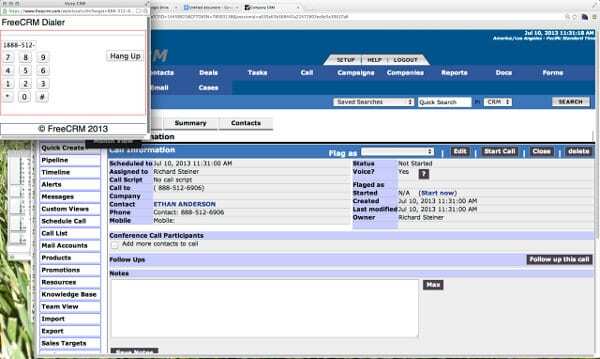Outbound calling from CRM made easy with WebRTC.
I had this notion that WebRTC reduces VoIP from a service into a feature. What better way to show it than to see how it can fit within the business processes that revolve around an enterprise CRM system?

This is what made me happy to see that FreeCRM took up the challenge and now allows their customers to dial out from within the CRM system to… anyone.
And I was even happier when Eric Stone, CEO of FreeCRM, was kind enough to spare some time for me and answer some of my questions about the integration they did with WebRTC.
What is FreeCRM all about?
We’re about making CRM accessible to everyone with a free but powerful CRM platform; we have a standard fremium model with premium services, like voice.
Where does WebRTC come into play in FreeCRM?
WebRTC has reached the tipping point and our web based CRM is a natural fit.
It’s always been hard to integrate voice unless you had all the best equipment in cutting-edge call centers – it’s just been hard to integrate legacy voice / PSTN easily in digital. VoIP has come a long way but it’s still technically challenging, and WebRTC breaks down the barriers and lets us deliver PSTN directly to our CRM app using nothing but the browser. It’s the seamless experience for users and the simplicity of using the browser as your communications device.

How has the uptake of this service been for you?
It has been tremendous, literally overnight our users were able to click to call any US phone number from the CRM; once everyone started using it, customers started asking for more and helping us drive the product roadmap.
Is this the first time you try to connect the calling part to the CRM part within your solution?
We have a long history, having launched in 2003 and have done a few voice integrations in the past but nothing close to what we can deliver today. In 2005 we integrated with a predictive dialer / PBX. We added Skype and Vonage in 2008 and a more general click-to-call system in 2010 which worked on callbacks and SIP clients.
What’s different this time around with WebRTC?
Technically, I think the big thing with WebRTC is that there’s a lot less mess, at least on the desktop. Hopefully we’ll see more browser support and progress on mobile.
WebRTC makes it easy and gives us the opportunity to integrate both PSTN and VoIP, delivering a blended service in a simple way with just the browser. WebRTC is completely transparent to the user experience – I just want to click to call, click to video conference, to chat – communicate without a plug in or download.
Have you used any API or “tooling” company for the WebRTC part?
No, we’re using Asterisk as our core and have a very high quality PSTN gateway partner.
What have you selected for the signaling path?
We’re lucky that we don’t have to worry about the PSTN side of things, we just terminate in SIP over local fiber direct to the media gateway (not over the internet).
Backend – what technologies do you use there for WebRTC?
Just a custom cluster of the latest Asterisk 11.4.
How was the experience for you guys for integrating something like WebRTC into a CRM system?
Pretty easy, since we’re not providing video and are focused on the PSTN side of things. Call quality is really amazing.
Given the opportunity, what would you change in WebRTC?
It’s just about distribution (mobile, browser support) since the changes that are being made and pace seem to be good and the community really has momentum.
What’s next for FreeCRM? Any additional plans around WebRTC?
We have a lot of plans in terms of functionality and features and will be announcing quite a few things later this year.
–
The interviews are intended to give different viewpoints than my own – you can read more WebRTC interviews.

I like how WebRTC offered them a small, clear subset of quickly deliverable capabilities so they build their Minimum Viable Feature. In the context of CRM this was a sustaining innovation (they and their customers know call center needs well) but WebRTC is finally mature enough FreeCRM could safely stick their toe in the water and confidently build something that works, that allowed their customers to test their demand for it, and to trigger conversations leading to richer features and more use. Even nine months ago WebRTC wasn’t ready for this. Now it is.